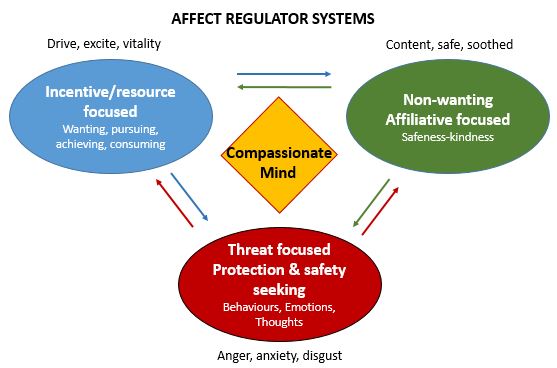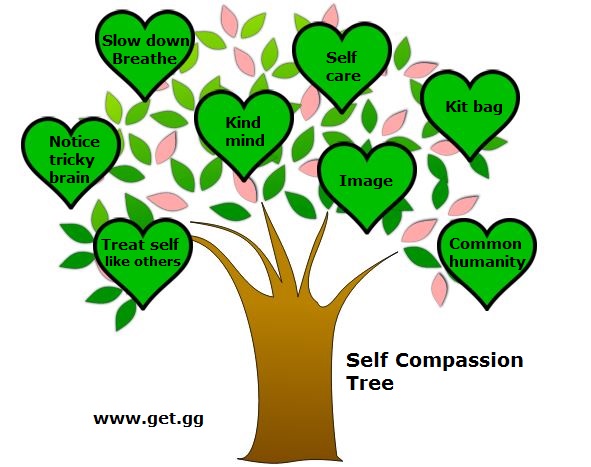Compassion Self Help
Introduction to Self Compassion For Shame, Self-criticism And Self-hate & Compassion Focused Therapy strategies for self help
Compassion Focused Therapy (CFT) is used to treat problems associated with shame, self-criticism and self-hate, which can be features of anxiety, depression, psychosis and strongly associated with childhood trauma.
Find out more about Paul Gilbert's Compassion Focused Therapy at www.compassionatemind.co.uk
Paul Gilbert (2011) says "compassionate mind training helps people develop and work with experiences of inner warmth, safeness and soothing, via compassion and self-compassion."

The Human Brain
Over time, the human brain has evolved in a way that serves primitive life well. It's primary function is to keep us alive. It has not evolved to maintain a healthy or positive mindset. Humans have developed the capacity to think about and mull over the past (ruminate) and the future (worry).
Humans have a "threat mindset" which helps us survive and keeps us safe. Unfortunately, the way it has developed means that it works TOO hard and sees danger where there isn't any.
These factors mean we are prone to have mental health problems. CFT is particularly helpful when we KNOW what we need to do or think, but we don't really believe or FEEL it. There is a mis-match between our heads (thinking) and hearts (emotions).
The brain is amazing, very complex, and well-designed for primitive life. However, because of our ability to over-think things and threat mindset, it is not best-suited for the way we live our lives now. Compassion Focused Therapy calls this "Tricky Brain".
Tricky Brain
It is helpful to remind ourselves about Tricky Brain when we get caught up in self-criticism, self-hate and feel shame.
The brain and neurobiology, human nature, and our life experiences all influence the way our mind works.
It is not our fault we think this way! We are simply doing the best we can. It's just the way the brain works.
CFT says there are 3 types of regulator systems that affect our state of mind:
- Incentive/resource focused - achievement, motivation
- Non-wanting affiliative focused - safeness, soothed
- Threat focused - seeks to protect us and keep us safe
When we've experienced repeated trauma, particularly early in life, then we spend a lot of time in our threat focused system, so our focus of attention, thoughts, feelings and behaviour are taken up with fear, danger and trying to keep ourselves safe.

Our Developing Mind
In addition to how the human brain has developed, the genetics we are given by our biological parents and our environment and early experiences affect how our mind develops.
In spite of our genes, it is our environment and early experiences which mostly affects our brain development. The same genes but a different early life will result in a different version of me. We are the "version of me" as a result of our lives to date. A different life would result in a different "version of me".
So once more, it is not our fault we think or react this way. We do the best we can, given those circumstances. It is not our fault, but it is our responsibility to change things now.
For example, if I park my car in a proper parking place, then returned later and found another car had crashed into it, it would not be my fault. However, it would be my responsibility to sort things out.
Shame
Shame is self-hatred and makes us feel like we cannot change.
We feel guilt about things we have DONE - "I've done a bad thing." We feel shame about ourselves - "I am bad."
If we feel we have been rejected by those people we consider "our group", then shame is the result. Sometimes we can do something to help us feel more included and accepted. But there may be other situations that we cannot change, such as our culture, aspects of our appearance, and past events.
Shame causes us to hide, withdraw from others and isolate ourselves.
Sometimes we try too hard to fit in with others, but keep hidden the parts of us that we think are shameful.
Sometimes, therapists talk about internal and external shame. Internal shame is what we feel about ourselves. External shame is what we THINK or believe others think about us.
Shame and self-hate leads us to self-criticism. Our internal mind bully (or parrot) that is almost constantly putting us down, reminding us of our shameful self, criticising us.
Common Humanity
We cannot escape pain and suffering. It is part of human life.
By Human Nature, we are social animals and we need to feel cared for and protected, accepted and valued by others, and to feel a sense of belonging.
Humans have a compassionate instinct...... for others. We feel good when we help or do something nice for others. When we injure a part of our body, we immediately do something to help it feel better. When we see someone hurt, we feel an urge to respond.
We can use that ability to feel natural compassion, and start to use it for ourselves - rather than believing those self-critical thoughts and get caught up in beating ourselves up - we can start to treat ourselves with compassion.

Compassionate Self Help
Learning to be more compassionate with ourselves leads to a calmer mind, better relationships, less anxiety and depression, and an increased sense of self worth.
Slow Down - Breathe
Just take a few moments to slow down, and breathe
Develop A Compassionate Image
Being able to use a compassionate image is central to Compassion Focused Therapy. We need to create and build an imaginary idea of compassion. It is best to use an object or idea that is NOT a REAL person. This is important, as nobody is perfect.
Whatever image you choose, it needs to have specific compassionate qualities and be: wise, understanding, kind, all-knowing, forgiving and totally accepting (of you, your past etc).
If you can only think about a real person, then change that person to look and become the best version of them, with those perfect qualities of compassion.
Start by just slowing down, and thinking about your breathing. Slow down your breathing a little and notice the rhythm of your breathing.
Notice what images come up and if you can use one of them. Build the image by thinking about:
- What would they look like? Human, animal, light, nature? Single or a compassionate team?
- What would they look at you if they were wise, understanding, kind and accepting?
- What expression would they have as they looked at you with wisdom, understanding, compassion and acceptance?
- How else would you like them to look?
- How would they communicate or interact with you?
- What voice would you give them?
- What would their voice sound like for them to sound wise, understanding, kind and accepting?
- What colour do you associate with wisdom, understanding, compassion and acceptance?
- How else would they communicate with you?
- What does your compassionate image want you to know? What words are they saying?
- What do you feel as you spend time with your compassionate image? What do you notice?
- Know that your compassionate image is yours and yours alone, is in your mind and therefore is there for you at all times.
Download Compassionate Imagery as PDF
Treat Yourself The Way You Treat Others
We are often very compassionate with others, but are much harder and more critical of ourselves. We are much more understanding and compassionate with someone else, particularly someone we care about.
Talk to yourself the way you would talk to someone else in the same situation.
"If someone else was telling me these things, what would I say to them?"
Start to replace "I'm sorry..." with "Thank you...". For example, if you arrive late for a meeting, say "Thank you for waiting for me.."
Self Compassion - video
Compassionate Mind / Kind Mind
Kind Mind helps us be more mindful of our thoughts and how we talk to ourselves.
Use your Compassionate Image.
Acknowledge that we have a Tricky Brain - this is not my fault, it's just how the brain works!
"I'm thinking this way because of Tricky Brain. What would compassionate mind say?" (Compassionate Image)
"If I was feeling calmer and less emotional right now, how else would I see this?"
Use THINK: Is this thought True, Helpful, Important, Necessary, Kind?
How to be a friend to yourself: video
Self Care
Look after yourself the way you would care for someone you loved.
- Eat healthily
- Ensure you get quality sleep
- Exercise regularly: BACES
- Plan activities you enjoy and/or find relaxing
- ACE: Achieve, Connect, Enjoy
- SEEK LIFT: Positive Steps to Wellbeing Be Gentle with Myself
Notice Tricky Brain or the mind bully (or poisonous parrot), and respond to your criticised self with gentleness and supportive understanding.
Acknowledge your difficult life experiences and challenges. Write your life story using the Time Line worksheet. Learn and understand that it's no wonder you think and react the way you do, given what you've been through.
Write a compassionate letter to yourself: see the Write webpage
Re-Routing
When we take a wrong turn when using satellite navigation, the Sat Nav simply finds an alternative route. It doesn’t say “You idiot! Why did you do that? Can’t you get anything right? Pay attention!”
The Sat Nav stays calm and rational, and simply finds an alternative route.
Be like a Sat Nav! Instead of beating ourselves up when we make a mistake, notice, then consider and take a first step on an alternative route.
Compassionate Self Talk
We all have internal dialogue in our heads, it is very often self critical and we judge ourselves far harsher than the way we judge other people. We can practise noticing when we do that, and start to use Compassionate Mind.
Bring your Compassionate Image to mind.
See situations using Compassionate Mind: If I wasn't feeling so emotional, how else would I see this situation?
Make a Compassionate Kit Bag for life's journey (Compassionate Kitbag PDF)




















